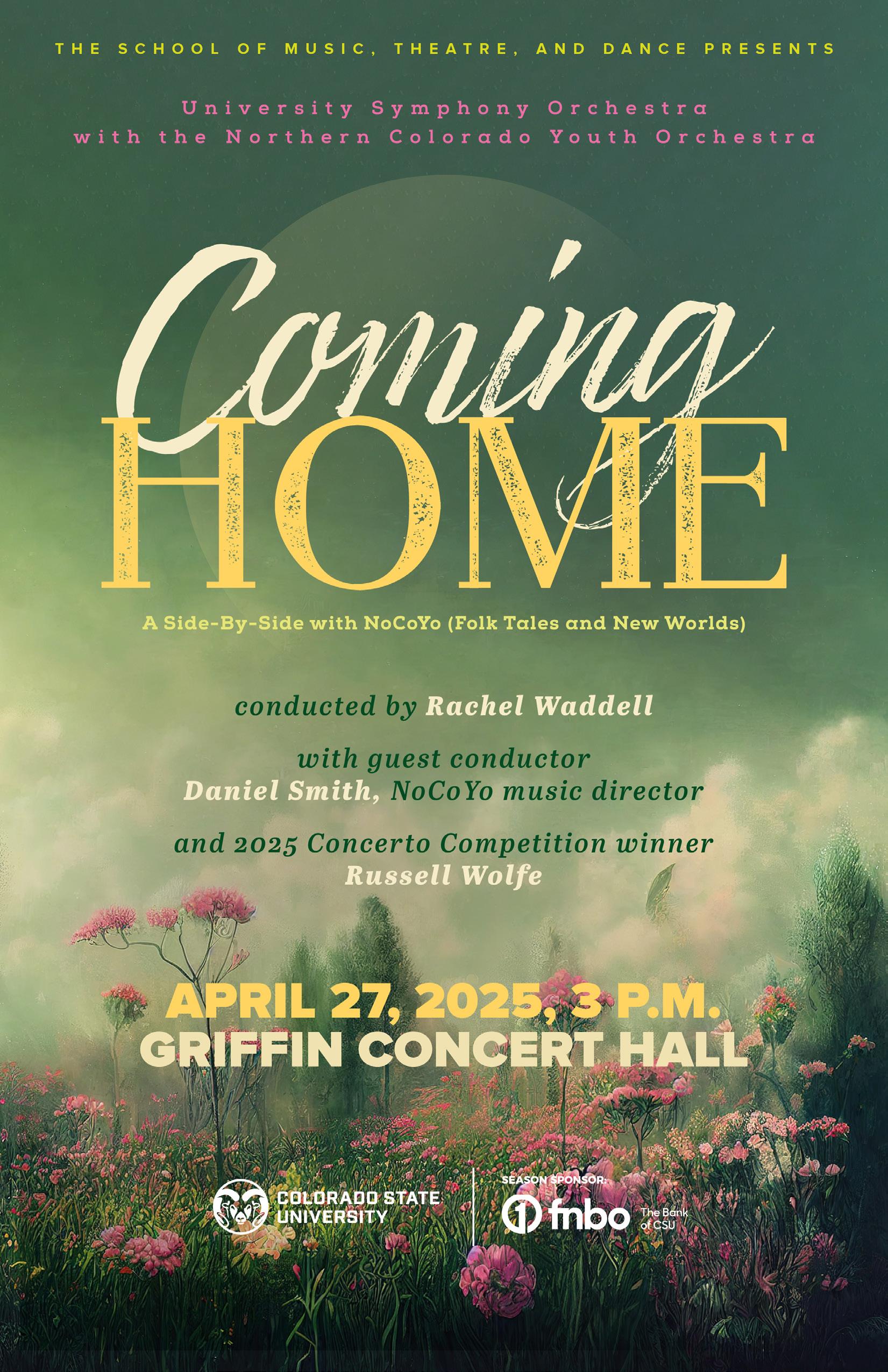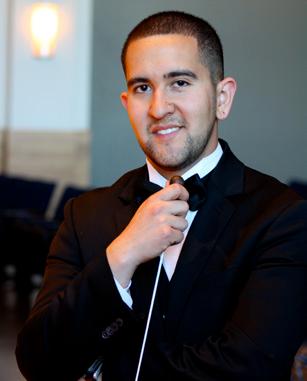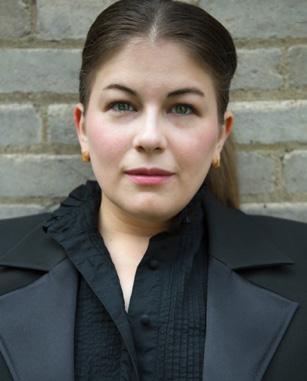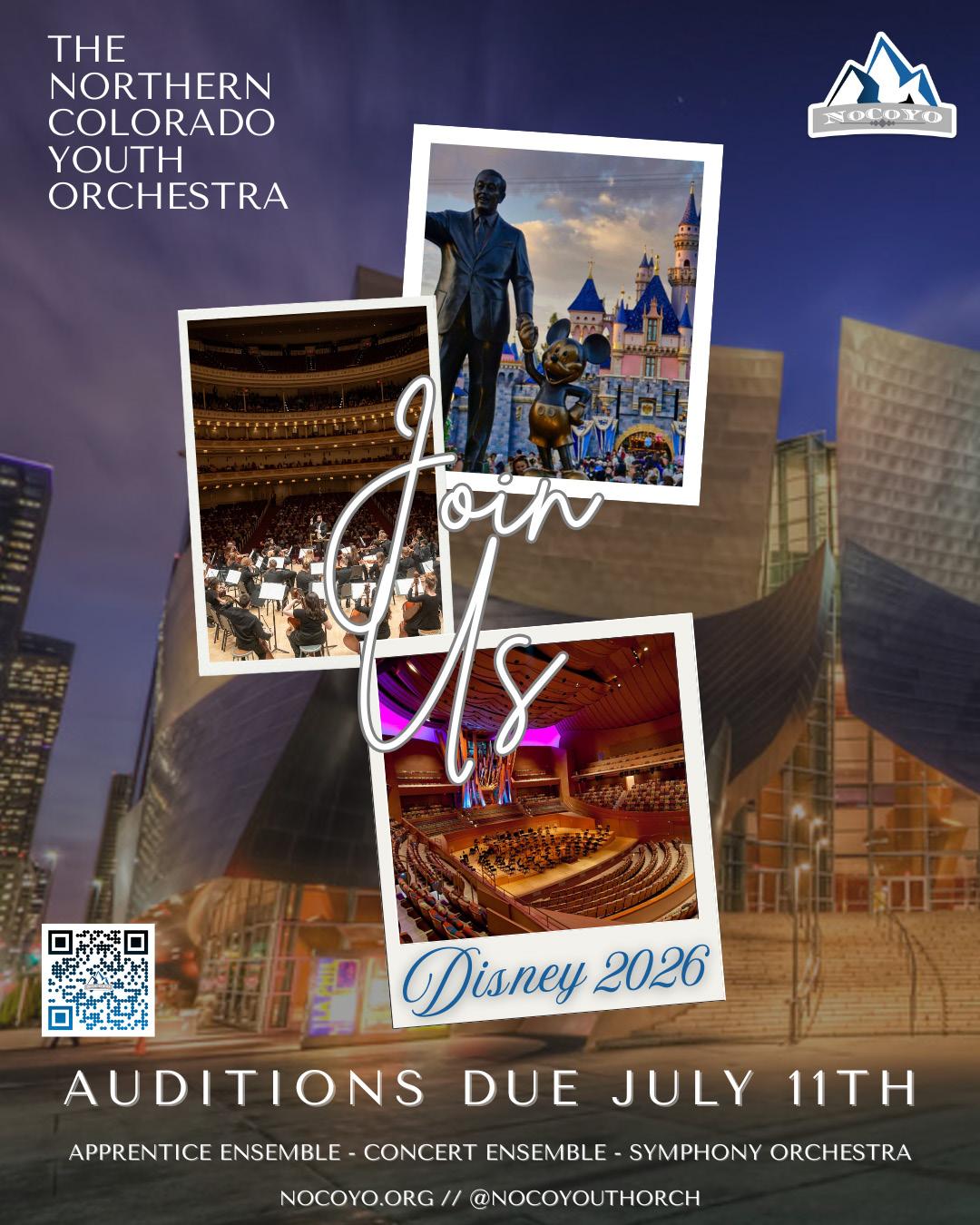SYMPHONY ORCHESTRA
APRIL 27, 2025 | 3 P.M. | GRIFFIN CONCERT HALL
COMING HOME: A SIDE-BY-SIDE WITH NOCOYO (FOLK TALES AND NEW WORLDS)
Follow Us on Instagram @CSUOrchestras
Program:
Scottish Fantasy Max Bruch (1838-1920)
Russell Wolfe, Violin
I. Introduction: Grave – Adagio cantabile
II. Scherzo: Allegro
Overture to Nabucco
Giuseppe Verdi (1813 - 1901)
Daniel F. Smith, Conductor
Symphony no. 9 in e minor Antonín Dvořák (1841 - 1904)
I. Adagio – Allegro molto
II. Largo
III. Scherzo: Molto vivace
IV. Finale: Allegro con fuoco
THE NORTHERN COLORADO YOUTH ORCHESTRA (NOCOYO)
Daniel F. Smith - Founder / Music Director
Joshua Greiner - Conductor
Drew Mendizabal - Conductor
Cathy Verbyla - Conductor
Prof. Barbara Thiem - Director of Chamber Music
Annie Smith - Administrative Assistant
WOODWINDS:
Isabelle Fortner - Flute 1
Adeline Burrow - Flute 2/Picc
Joyce Chen - Clarinet 1
Ashley Artlip - Clarinet 2
Abby Fernandez - Oboe 1
Elias Bouchard - Bassoon 1
Rachel McReynolds - Bassoon 2
BRASS:
Benjamin Sundheim - Trumpet 1
August Willhite - Horn 3
Owen Jensen - Trombone 1
Jake Jackel - Tuba
PERCUSSION:
Burke Mitchell
Caden Straw
VIOLIN I:
Elsa Andersen - CM
Kurt Hoyer - AP
Nicole Gallego
Isaiah Furuiye
Micah Scherman
Angela Wang
Bennett Kemp
Charlinn Lawler
VIOLIN II:
Yuki Chen - P
Anne Ritschard - AP
Cole Perry
Coara Malinski
Xavier Jones
Ke Qu
Diana Bradford
Kacy Larson
VIOLA:
Elias Everitt - CP
Herbert Crisman - AP
Addison Oulette
Maise Nettles
CELLO:
Sophia Long - P
Louisa Mitchell - AP
Kirsten Lambert
Ethan Straw
Clara Mullins
Gerald Lawler
Annika Everitt
James Russell
Shea Archie
DOUBLE BASS:
Willa Payne - P
Ovella Huddleston - AP
Robert Call
Oliver Gibbons
Willem Steneck
DR. RACHEL WADDELL, MUSIC DIRECTOR AND CONDUCTOR
SAM COOPER, ASSISTANT CONDUCTOR
* = Graduating Student
FLUTE
Verdi:
Elizabeth Movinsky, Principal
Ben Rogers
Bruch:
Elizabeth Movinsky, Principal
Madison Tallman
Dvorak
Madison Tallman, Principal
Ben Rogers (2nd/Picc)
OBOE
Madina Rashidova, Principal
Sophie Haase, Oboe 2/EH
CLARINET
Peter Hansen, Principal
Bradley Irwin
BASSOON
Verdi:
Evelyn Underwood, Principal
Michael Coffey*
Bruch:
Charlie Beauregard, Principal
Evelyn Underwood
BASSOON (cont.)
Dvorak
Charlie Beauregard, Principal
Michael Coffey*
HORN
Verdi:
Sophia Marino, Principal
Erin Wilson*
Jacob Andersen*
Zoe Huff
Bruch:
Sophia Marino, Principal
Erin Wilson*
Jacob Andersen*
Zoe Huff
Dvorak:
Jacob Andersen*, Principal
Erin Wilson*
Sophia Marino
Zoe Huff
TRUMPET
Will Hiett*, Principal
Lauren Smith
TROMBONE
Hannah Steward, Principal
Silas Riep
Andrew Zimbelman, Bass
TUBA
Carson Ross*, Principal
PERCUSSION
Stuart Hoskins*, Principal
Lucille Harlow
Hannah Engholt
Neo Shaffer
HARP
Katerina Mead, Principal
VIOLIN 1
Cesar Reyes*, Concertmaster
Russell Wolfe
Ella Batson
Kirby Miller
Li Gomez
Sasha Latham
VIOLIN 2
Kathryn Carlos, Principal
Mason England
Lamarana Balde
Melissa Kelley
Haley Rieger
Jordan Olson
Grace Bennet
Shanon Cooper
VIOLA
Shawn Murphy*, Principal
Charlie Wootton
Cassidy Hall
Madison Ramonette
Percy Slovut*
Emily Rowe*
Genesis Tyler
CELLO
Axel Gallegos, Principal
Amy Effinger
Matthew Fox
Aurora Farrel
Mae Ferry*
Zuzu Davis
Alex Strobel
Cora Larson
Lillian Rogers
BASS
Max Williams, Principal
Lucy McHugh
Nick Hailey
Alison Podgorski
Jojo Matibag
Isaac Hermanson
LIBRARIANS
Dr. Ethan Urtz, Head Librarian
Devon Bignell
Cora Larson
SET-UP CREW
Alison Podgorski
Hannah Steward
CSU WOODWIND FACULTY
Dr. Cayla Bellamy
CSU STRING FACULTY
Ron Francois, Violin
Margaret Miller, Viola
Dr. Meredith Blecha-Wells, Cello
Dr. Forest Greenough, Bass
PROGRAM NOTES
Scottish
Fantasy
Max Bruch (1838-1920)
German composer Max Bruch wrote his Scottish Fantasy in 1880, fourteen years after he completed his first violin concerto. Bruch resented the popularity of his concerto and embarked on a new work for violin and orchestra based on Scottish folk tunes. Scottish Fantasy lives between the concerto and fantasia. Its four movements musically portray the writings of Scottish novelist and poet Sir Walter Scott. The solo violin, accompanied by a virtuosic harp part, portrays a storyteller, winding through various folk tunes with the cyclic return of “Through the Woods, Laddie” tying them together. The introduction moves seamlessly into the first movement, presenting this memorable, recurrent theme for the first time. In the contrasting second movement, composed as a Scherzo, the orchestra offers bagpipe-esque drones while the solo violin provides variations on Hey, the Dusty Miller. While we perform the introduction and first two movements for you today, the remaining two movements are also based on Scottish melodies. The sweeping Andante offers a poignant rendition of I’m Down for the Lack O’ Johnnie, while the final, dance-like movement proudly presents Scots what hae. Bruch dedicated the work to the Spanish violinist, Pablo de Sarasate.
— Program Notes by Rachel L. Waddell
Overture to Nabucco
Giuseppe Verdi (1813 - 1901)
While Giuseppe Verdi likely worked on his third opera, Nabucco, for a while, he did not complete it until 1841. It premiered at La Scala on March 9, 1842, cementing Verdi’s career as an opera composer. The libretto, written by Italian opera composer Temistocle Solera, pulls from biblical inspiration (2 Kings, Jeremiah, Lamentations, and Daniel), the 1836 play by Auguste Aniret-Bourgeois and Francis Cornu, and Antonio Cortese’s ballet adaption of that play. Nabucco takes place in 587 BC in Jerusalem and Babylon. It follows the plight of the Hebrews and their assault by the Babylonian King, Nabucco. Over the opera’s four acts, we follow the ill-fated love of Israelite Ismaele and Nabucco’s younger daughter, Fenena. In a poignant story of surprise, betrayal, power, and forgiveness, Nabucco discovers new faith and is re-named king of the Israelites by Zaccaria, the high priest.
This overture provides a musical outline of the drama to come, beginning in the low brass with the theme of the Hebrews, representing steadfast faith. Il maledetto, the curse of the Israelites against Ismaele for betraying his people, follows. Over the course of the overture and opera, this theme returns through several reiterations, paralleling the transformation of faith over time. After a brief interruption of the opening theme, the overture presents the opera’s most famous melody “Va, pensiero”, a poignant chorus by the Hebrew slaves as they long for their homeland. Though physically enslaved, this chorus offers a bittersweet consolation: the freedom of their thoughts to go wherever they wish, including their homeland. Unallowed to dwell in their sorrow for long, the overture launches forward in a Rossini-esque coda, as Il maledetto returns.
— Program notes by Rachel L. Waddell
Symphony no. 9 in e minor
Antonín Dvořák (1841 - 1904)
Antonín Dvořák’s Symphony No. 9 in e minor is often subtitled, “From the New World” or “Impressions and Greetings from the New World.” Indeed, Dvořák composed his final symphony in New York City from 1892-1893, having relocated to the United States to direct the National Conservatory of Music, founded by Jeanette Thurber. Thurber wanted to create a French-inspired conservatory, funded by the government, and opened to all. Thurber believed in equal access to music education and charged Dvořák with finding the American sound. When Dvořák and his family arrived in the United States on September 27, 1892, they were surprised to find the country less than welcoming, and Dvořák was brandished for his support of African American and Native American music, which he proclaimed as the roots of American folk music and the future of classical music in our country.
This symphony, considered groundbreaking for its cyclic repetition of themes, premiered in New York City on December 15, 1893, by conductor Anton Seidl and the New York Philharmonic. Its four movements center on home, homesickness, and roots, as Dvorak intersperses themes inspired by Native American music and African American spirituals with Czech folk tunes. The symphony seems to search for home by a composer charged with finding ours. Dvořák found temporary solace in the small Czech enclave of Spilleville, Iowa, but he was too distraught by the vast landscape to find peace. He ultimately returned with his family to Prague in March 1895.
The first movement begins as a daydream, interrupted by a steamboat (e.g., horn call). One can imagine a more modern scene of a composer’s focus continually interrupted by New York
City taxi cabs. What follows are three themes presented in sonata-allegro form. The second movement received the title “Going Home” 30 years after its composition when William Arms Fisher set its famous melody to lyrics in 1922. Nevertheless, one cannot help but feel a distance and aching homesickness in this movement’s harmonic relationship to the e minor symphony. Composed in Db Major, this movement is harmonically as far away from e minor as Dvořák likely felt from his home. Both the second and third movements may be inspired by American poet Henry Wadsworth Longfellow’s The Song of Hiawatha, which follows Native American folklore about Hiawatha, an Onandaga chief (currently the county where Syracuse, New York is located). This movement also draws undeniable similarities to the scherzo in Beethoven’s 9th Symphony. Much like Beethoven’s ninth, Dvořák’s final movement recollects each of the prior movements. Its heartfelt emotion and memorable melodies have made it one of Dvořák’s most widely performed and beloved works.
— Program notes by Rachel
L. Waddell
The Northern Colorado Youth Orchestra would like to express our heartfelt gratitude to all those who make our season possible. To our incredible musicians—your dedication, passion, and artistry continue to inspire us. Thank you for bringing your best to every rehearsal and performance. To our families—your unwavering support and encouragement allow our students to thrive. Thank you for every ride, every reminder, and every word of encouragement. To our teaching staff and conductors—your leadership, mentorship, and commitment to musical excellence shape the future of every young artist in this ensemble. To our administrative staff and volunteers—your behind-the-scenes efforts keep NoCoYO running smoothly. Thank you for your time, talent, and belief in our mission. To our donors and sponsors—your generosity ensures access to high-quality music education and unforgettable experiences for young musicians across Northern Colorado. To our community partners, schools, and venues—thank you for opening your doors and hearts to our students. Your support helps us inspire harmony for tomorrow. And finally, to everyone in the audience tonight—your presence affirms the value of music education in our world. Thank you for celebrating this moment with us.
THE CSU SYMPHONY ORCHESTRA WISHES TO THANK:
Dr. Galit Kaunitz
Mike Solo
Valerie Reed, Peter Muller, and their Team
Jennifer Clary
Nicole Darling
Jim Doser
Dr. Ethan Urtz
Devon Bignell
Cora Larson
Alison Podgorski
Hannah Steward
Sam Cooper
COLORADO STATE UNIVERSITY MUSIC APPLIED FACULTY
Violin
Ron Francois
Viola
Margaret Miller
Cello
Meredith Blecha-Wells
Bass
Forest Greenough
Guitar
Jeff Laquatra
Flute
Ysmael Reyes
Michelle Stanley
Oboe
Galit Kaunitz
Clarinet
Wesley Ferreira
Saxophone
Peter Sommer
Dan Goble
Bassoon
Cayla Bellamy
Trumpet
Stanley Curtis
Horn
John McGuire
Trombone
Drew Leslie
Tuba/Euphonium
Chris Bloom
Percussion
Eric Hollenbeck
Shilo Stroman
Harp
Kathryn Harms
Piano
Bryan Wallick
Tim Burns
Organ
Joel Bacon
Voice
Nicole Asel
Tiffany Blake
John Lindsey
Russell Wolfe
Russell Wolfe, 20, began taking violin lessons from Erin Webb at the University of Memphis Community Music School when he was three years old. He went on to study under Pak Chung Cheng and Barrie Cooper, and now studies with Ron Francois at Colorado State University, where he is a sophomore pursuing a Bachelor of Music in Violin Performance.
In 2022, Russell won his category of the Beethoven Club of Memphis Young Artist Competition. He was a member of the Memphis Youth Symphony Program for eight consecutive seasons where he served various roles including concertmaster and 2023 concerto competition winner. In high school, Russell served as concertmaster of the White Station High School Orchestra and he has attended various orchestras and festivals, including the Memphis Summer Music Festival, Philadelphia International Music Festival, and Tennessee Governor’s School for the Arts.
Alongside his musical studies, Russell is pursuing a Bachelor of Mathematics and a Minor in Chemistry. Russell enjoys backpacking, backcountry skiing, and is an avid long-distance runner. He completed his first ultramarathon when he was 15 years old, and has since completed 13 such races.
Daniel F. Smith Founder & Artistic Director, The Northern Colorado Youth Orchestra
Daniel F. Smith is the Founder and Artistic Director of The Northern Colorado Youth Orchestra, an organization he established in 2020 in response to the challenges facing music education during the COVID-19 pandemic. Under his visionary leadership, NoCoYO has grown from three socially distanced string ensembles to a nationally recognized program serving over 120 students annually. The organization now includes multiple large ensembles, including The Apprentice Ensemble, The Concert Ensemble, The Symphony Orchestra, and a chamber music program.
Mr. Smith’s achievements with NoCoYO have garnered national attention. In 2022, the Chamber Orchestra was selected to perform at the American String Teachers Association
(ASTA) National Orchestra Festival, placing third in the nation. In 2024, the orchestra performed at Carnegie Hall, premiering Interstellar Dreams by Colorado composer Chris Pilsner. NoCoYO is currently preparing for its debut at Walt Disney Concert Hall in Los Angeles in 2026. In recognition of his work, Mr. Smith was honored as the ASTA String Teacher of the Year in 2021.
A dedicated educator and conductor, Mr. Smith also serves as Director of Orchestras at Loveland High School and Lucile Erwin Middle School, where he oversees a comprehensive program of sixteen ensembles spanning grades six through twelve. His orchestras consistently receive superior ratings at regional and state festivals, and the Loveland High School Chamber Orchestra has qualified for the ASTA State Festival every year under his direction.
Mr. Smith holds degrees in Music Performance and Music Education from Colorado State University. He served for sixteen years as Principal Bassist with the 101st Army Band and has maintained a successful private studio, The Arco / Pizzicato Music Studio, for over two decades. His professional affiliations and collaborations extend throughout Colorado, where he remains an active performer, clinician, and advocate for youth in the arts.
Through his work with NoCoYO and the broader musical community, Mr. Smith continues to champion the mission of Inspiring Harmony for Tomorrow, creating transformative musical experiences that nurture young artists and strengthen the future of classical music.
Rachel Waddell
With energy, imagination, and a passion for people, American conductor Rachel Waddell proves an unabashed advocate for the 21st century orchestra. Her leadership across the country demonstrates her innate ability to transform vision into action. Rachel believes by uplifting, celebrating, and reflecting the artistry of our neighbors, orchestras become the creative heartbeat of our communities. Through breathtaking collaborations and an untiring dedication to education, mentorship, and community, Rachel inspires transformative experiences and ensembles.
Rachel serves as the Director of Orchestras at Colorado State University. Rachel’s contributions to music education were recognized in 2024, when she was named a quarterfinalist for the 2025 Music Educator Award through the GRAMMYs. She is a popular clinician and guest conductor throughout the country. She conducted the Texas Music Educators Association All State Sinfonietta Orchestra in 2025, and the AA Montana Festival Orchestra in Helena in 2024. Previously she was the Director of Orchestral Activities and Assistant Professor
with the Arthur Satz Department of Music at the University of Rochester in New York. The UR Orchestras gained recognition as a two-time national winner for the American Prize’s Vytautas Marijosius Memorial Award in Orchestral Programming in 2019 and 2020. In 2021, they won international acclaim in collaboration with conductor Tiffany Chang and Oberlin Conservatory through a digital performance of Beethoven’s Choral Fantasy, named Best Instrumental Performance of 2021 by the LIT Talent Awards.
Rachel maintains a busy profile in the professional and academic worlds. She has conducted orchestras around the world including the Orchestre Métropolitain, the Rochester, Las Vegas, Fort Wayne, and Denver Philharmonics, the Greater Bridgeport Symphony, the Southwest Michigan Symphony Orchestra, and Cleveland’s Suburban Symphony. While serving as the Associate Conductor of the Canton Symphony Orchestra in Ohio, Rachel conducted over 80 performances of classical, pops, and education concerts. She has attended numerous conducting programs including the Dallas Opera’s prestigious Hart Institute for Women Conductors, and Mark Shapiro’s Conducting Intensive at Juilliard. In August 2022 she made her Vienna debut conducting Così fan tutte as part of the Vienna Opera Academy. In July 2023 she made her Canadian debut with the Orchestre Métropolitain, after being selected to conduct by Yannick Nézet-Séguin at Le Domaine Forget de Charlevoix.
Rachel’s interest in the constantly evolving role and responsibility of orchestras within their communities led her to co-found Conductors for Change, Inc., a 501(c)(3) for anyone reimagining the future of the American orchestra.
Rachel holds a DMA in Orchestra Conducting from the University of Nevada, Las Vegas, and a certificate in Music Industry Essentials from the prestigious Clive Davis Institute of Recorded Music at NYU’s Tisch School of the Arts.
To learn more about Rachel Waddell please visit www.rachelwaddellconductor.com






